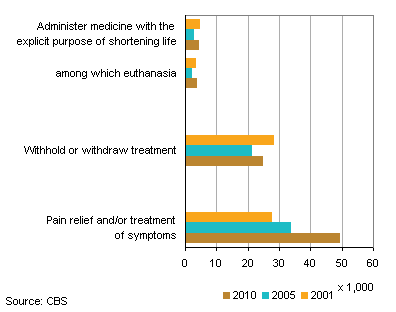Euthanasia carried out in nearly 3 percent of cases

Nearly six in every ten deaths in 2010 involved medical end-of-life decisions. In 2.8 percent of cases, euthanasia was carried out, versus 1.7 percent in 2005 and 2.5 percent in 2001.
Mostly pain or symptom relief
More than 78 thousand deaths involved a medical end-of-life decision in 2010, i.e. 58 percent of total mortality in that year. This is shown in the Mortality Survey 2010 conducted by the VU University Medical Centre, the Erasmus Medical Centre Rotterdam and Statistics Netherlands and commissioned by the Netherlands Organisation for Health Research and Development (ZonMw).
Medical end-of-life decisions include various types of actions. Pain relief and/or symptom treatment are most common (in nearly 50 thousand cases or 36 percent of total annual mortality in 2010). Pain and symptom treatment have increased most compared to 2005 and 2001, when respectively 34 thousand (25 percent) and 28 thousand (20 percent) of deceased were involved.
Deaths involving a medical end-of-life decision

Euthanasia most common among cancer patients
End-of-life decisions may also include withhold or withdraw treatment or administer drugs with the explicit purpose to hasten the patient’s death. Euthanasia is included in this last category. In 2010, euthanasia was carried out among more than 3,800 persons or 2.8 percent of total annual mortality that year. In 2005 and 2001 2,300 (1.7 percent) and 3,400 cases (2.5 percent) respectively were involved.
Eight in every ten cases of euthanasia involve cancer patients versus three in every ten overall.
Cancer mortality, 2010

Estimated life-shortening effect
When a doctor prescribes or administers a drug with the explicit intention of hastening a patient’s death, life was shortened by at least one week in nearly 90 percent of cases.
Gwen de Jong, Bregje Onwuteaka-Philipsen (VU medical centre), Agnes van der Heide (Erasmus MC)